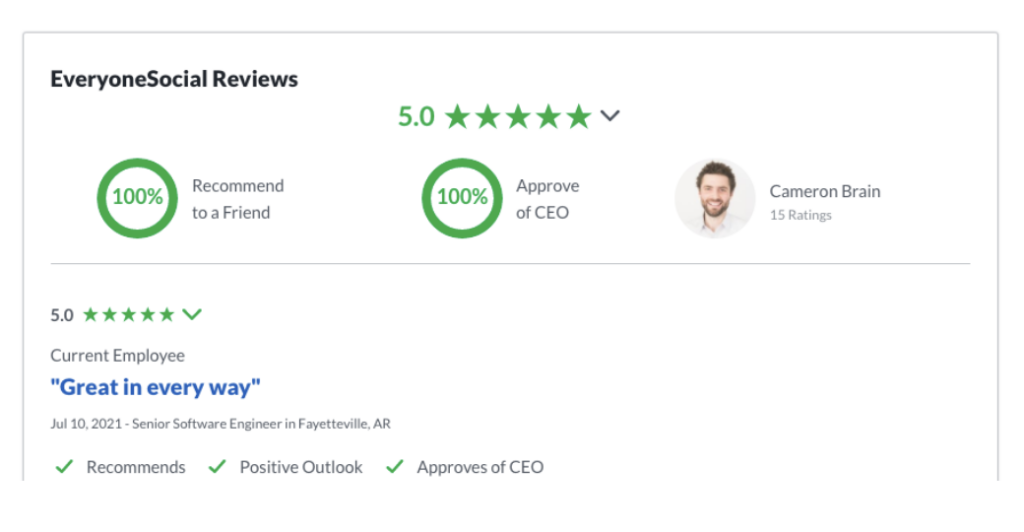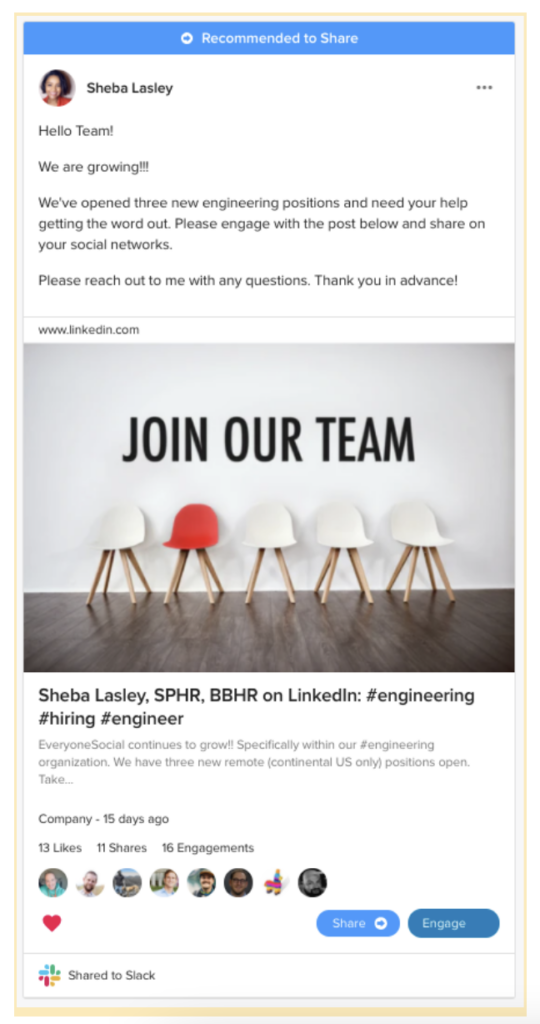Does sifting through app store listings, G2 reviews, and a deluge of lackluster blog posts covering how to pick the right employee apps have you feeling slightly overwhelmed?
You’ve come to the right place.
We created the definitive (and not boring-as-heck) guide to everything employee-app related. You’re just trying to set your team up for success and we just want to set YOU up for success, too!
First off, here are some things to keep in mind throughout the decision-making process, including while you’re reading this:
- What are you using the app(s) for?
- How many employees will use it? How many separate departments?
- What features are “must have” and what “would be nice”?
- How much of a budget are you working with?
- Are there integrations with other apps you’re already (or would like to start) using?
And, perhaps most importantly:
- Is the platform whose app you’re considering dedicated to both continually improving their product AND helping your organization succeed?
Just some food for thought. Let’s dive in, shall we?
What is An Employee App?
An employee app is a tool that enables employees to receive personalized and timely information from the organization on either company or private mobile devices. This allows employees to stay connected and in the loop from anywhere in the world.
With the proliferation of remote work, the most effective employee apps have a mobile version of their platform as well, enabling people to access content from anywhere at any time!
That accessibility works in both directions, by the way — mobile apps also allow organizations to reach employees via messages, push notifications, etc.
Depending on the context they’re used in, employee apps can range from intranets to messaging services to employee advocacy platforms (and more).
Why Mobile Employee Apps Matter
In 2019, the average adult spent three hours and 43 minutes on mobile devices every day.
The Covid-19 pandemic increased the average to more than four hours in 2020, and in this 2021 survey, 46% of respondents spend five to six hours on mobile each day.
You wanna know the crazy part? None of those numbers even account for work — they’re just talking about personal usage. 😳
Nowadays, mobile accounts for 54.8% of global web traffic. I feel the need to repeat the word GLOBAL. As in, over half of the internet activity in the ENTIRE WORLD is happening on smartphones and tablets.
The last piece of data that I’ll throw at you (for now) is this: a 2019 Pew Research Center survey found that 82% of U.S. adults get their news online at least sometimes, with 57% of respondents saying they “often” get it via mobile.
In other words, bringing information or resources to where your employees already spend their time makes it easier to keep them informed and connected!
6 Reasons Your Company Needs An Employee App
Let’s take a look at why your organization needs an employee app.
1. Modern organizations shouldn’t tie people to their desks.
We mean that literally and figuratively.
Jokes aside, we’re living in an era of unprecedented technological advancements, so throw a bone to your hardworking employees! Nowadays, nearly everything you can do from a desktop computer can also be done from a smartphone or a tablet, so why not just let them?
More than 2.7 billion people in all various industries, from agriculture to healthcare, are already deskless employees. But of the $300 billion business technology market, only $3 billion is directed toward the deskless.
If you’re even half as rad of a company as we are, you’re probably pretty flexible with travel and time off. The few employees that want to check their work apps before boarding a plane or while gassing up on their road trip are gems and should absolutely be enabled to do so.
Employee apps are also fantastic for keeping frontline workers in the loop, and considering they’re the face of your organization, that’s…important.
2. They promote regular interaction among employees.
As bad as it sounds to say, it’s pretty easy to not care that much about your co-workers. I’m not saying that’s how it should be, but let’s be honest here.
One of the best ways to combat that kind of toxic, apathetic environment is to simply get people talking more!
Cross-team discussions help illustrate the impact each team has on the company as a whole, and I’m speaking from experience there.
Even if it’s not work related, just chatting helps too — if anything, it’s even more beneficial for building camaraderie than shop talk is!

And in our opinion, the more pet photos, the better.
3. Employee apps reduce instances of “Oh, I didn’t see that email!”
It’s frustrating when you send out an announcement only to have, like, less than 30% of your workforce aware of it even weeks later, right?
Make that a problem of the past by adopting an employee app that allows you to notify employees whenever you need (and in especially important cases, even if they have other notifications turned off 😉).
Whether you’re letting your employees know about new policies or inviting them to an upcoming lunch-and-learn, this is a valuable feature.
It’s also super beneficial in instances of crisis communication when your organization needs to let everyone know about something ASAP.
As we saw at the beginning of Covid-19, virtually every company on the planet had to pivot extremely quickly and employee apps help facilitate those changes.
4. They allow employees to quickly and intuitively create their own content.
This point is fairly straightforward: If you make it easy for your people to create and share content, chances are pretty high they will!
Maybe they’re just sharing out a link to a study or an article, maybe they’re creating a mini blog in the app platform, maybe it’s something else entirely.
Whatever it is, the ability to customize that content with things like rich text editing tools, for example, is key.
5. You get an accurate feel for what your people care about.
If you’ve spent any amount of time doing research on psychology, you’re probably aware that people often don’t self-report accurately.
If you’re trying to figure out what kind of content resonates with them, however, that’s not particularly helpful.
Well-built employee apps can provide analytics and insights into what people are engaging with and which posts they’re actively sharing, so you can figure out the common themes yourself!
6. They give organizations customizable, airtight information security.
(security designation compliance, restricted access, private groups, authenticated users)
Finally, employee apps give you control over your company’s information.
For example, you can prevent certain kinds of content, like internal policy revisions or product roadmaps, from being shared while still using them to keep your people informed.
Private groups and authenticated users are other ways to make sure that sensitive information doesn’t get accidentally disclosed.
On top of what you can do yourself, it’s quite common for platforms themselves to be held to various security & compliance regulations, especially when it comes to social media or communications.
What are some examples of employee apps?
Really, any app that’s used in the workplace could be classified as an employee app, but below are some of the most common categories.
And yes, there can be some overlap between these, but let’s not be too nitpicky. 😉
Employee Communications Apps
These kinds of platforms are ubiquitous in the business world, and there’s a good chance your organization is already using some of these!
Nowadays, staying connected with your team is crucial for project management and effective collaboration. Consequently, there’s a pretty wide variety of software options available to choose from that cater to all sorts of uses.

Video conferencing? There’s an app. File sharing? Of course there’s an app for that. Here are some great communications apps that you can use to keep your team more organized and efficient.
- Apps for virtual meetings and messaging: Slack, MS Teams, Zoom, and Google Meet
- Apps for project management and collaboration: Trello, Monday.com, and Jira
Employee Development Apps
Keeping your employees learning is crucial for their long-term success. Professional development should be an ongoing process at your organization, and there are lots of apps you can use to facilitate that!
Ongoing training has been shown to increase employee performance and by utilizing a corporate LMS (Learning Management Systems) or Digital Adoption Platform, you can smooth out your onboarding process as well.

While a lot of people are vaguely aware of LinkedIn Learning, many businesses fail to encourage their employees to actually use it! Here at EveryoneSocial, we make sure to do exactly that.
Other great employee development platforms include: Udemy, Moodle, BetterUp, and Skill Pill!
Employee Engagement Apps
If you want your employees to be more satisfied with their jobs (which you most definitely should!), then you’ll also want to consider using an app to help keep your employees engaged.
Also known as employee advocacy platforms, these apps help keep employees connected to both each other and the C-suite, regardless of their location.
That’s just one reason that companies with remote workforces or dispersed employees have gravitated toward using platforms like EveryoneSocial.

Using platforms like these enable you to build a sense of community, but they also have the benefit of serving as word-of-mouth marketing channels.
Activating your employees on a platform that encourages them to create and share relevant content to their social media channels makes them active participants in your company culture AND turns them into brand advocates.
We’ll cover this in more detail a little bit further down, don’t you worry.
Employee Evaluation Apps
Tracking employee performance is especially important when it comes to conducting annual reviews, giving raises, and more.
In a blog post from a while back, we mentioned that you shouldn’t rely on your memory during these reviews, so why not help yourself out by using an app?
Not only do these platforms provide a way for you to ensure employees meet expectations, but they also provide personal systems for goal tracking, too!
After all, these aren’t mindless drones we’re talking about— they’re professionals with their own aspirations and expectations.
Giving them the tools to hold themselves accountable removes your temptation to micromanage them, leading to a better workplace culture overall.
Popular apps used for evaluation and goal-tracking purposes include Lattice, PerformYard Talent, TrakStar, and SageHR!

However, you can also consider letting your employees evaluate you in return, by encouraging them to leave an anonymous review on platforms like Glassdoor.
Employee Portal Apps
Last, but certainly not least, employee portal apps are VITAL for organizations looking to make life easy for their workers.
Most often, these are the kind of platforms where employees can see things like payroll information, HR policies, company calendars, and so on.
If you’ve ever used an intranet, then you’ve interacted with a company portal, but that’s kind of a “a square is a rectangle, but a rectangle isn’t always a square situation.”
In other words, intranets can serve as company portals, but that doesn’t mean your portal app will necessarily be a full-fledged intranet.
We use an app called Zenefits here at EveryoneSocial, and it’s quite handy. I can log in and check out my pay stubs, tax forms, and health insurance information. Plus, I can see the entire organizational structure.
Smartsheet, Jostle, and Boardable are a few other options that are available to companies in need of a portal.
Managing Employee Apps
One thing that’s important to highlight here is that you should be careful about having too many different employee apps.
If your organization uses 20 different tools to communicate, collaborate, and engage, you risk overwhelming people. That’s why you should try to pick a few that 1) serve multiple purposes and 2) play nicely together!
For example, EveryoneSocial can serve as a hub for content storage, sharing and creation. It’s also great for internal comms purposes, and for generating engagement among your employees!
Our integrations list isn’t too shabby, either. 😎
Use EveryoneSocial as an employee app
You’re probably wondering where we fit into this equation, right? Well, our platform is quite versatile, and can meet several needs simultaneously.
As an employee advocacy platform, EveryoneSocial excels at getting employees more engaged with their organization, and it’s pretty dang good for social selling, too.
Say you’ve got a company post coming up that you want to help get some early traction. Why rely on the social media algorithms that nobody REALLY understands when you could just whip up a quick “Engage” post in EveryoneSocial?

For example, if you’re looking to up your recruiting game, EveryoneSocial can help.
Did you know that employee referrals are likely to be some of your best candidates? In fact, only 7% of job applicants come from referrals, but they account for 40% of new hires!

As I’ve stressed repeatedly throughout this blog, keeping your employees in the loop is important for a healthy workplace environment. In fact, 85% of employees say they’re more motivated when management provides regular updates on the company.
You know something else EveryoneSocial is really good for? Making sure that everyone on your team sees important updates.
We actually have the option to mark a post as “important” so that your people get push notifications and an email alert, as well as see it flagged in their feeds! You can even pin posts for extra visibility.

I could keep going with these examples, but you probably have other things to do today, so I’ll wrap it up here. That being said, feel free to check out these links if you do want to know more about using EveryoneSocial in specific scenarios!
















